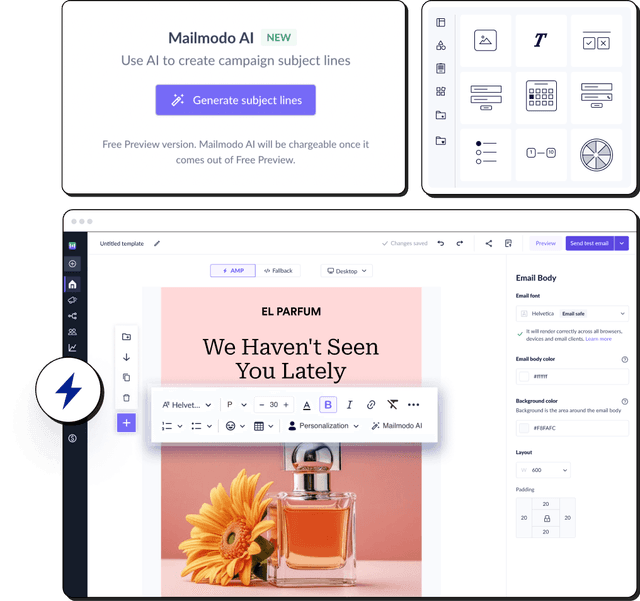What is BIMI?
Brand Indicators for Message Identification (BIMI) is a standard that adds your brand logo to your email messages in supported inboxes.
It’s a visual verification that helps your recipients recognize and trust the messages you send. Not only this, it allows your brand to stand out in inboxes over other emails.

Not just that, it provides your brand the ability to stand out in inboxes over other emails.
Free Tool: Use free BIMI Record Checker to validates your domain's BIMI record for correct syntax, DNS configuration, and logo compliance.
Why is BIMI important for email marketers?
Implementing BIMI can significantly enhance your email marketing strategy, and here's why.
1. Differentiates you from the competition
BIMI allows your brand’s logo to appear next to your email in the recipient's inbox. This visual identifier helps your emails stand out among a sea of messages, increasing brand recognition and making your communications more memorable.
This visual presence helps your emails stand out amidst a crowded inbox, making it easier for recipients to recognize and remember your brand.
2. Improved email deliverability
Most of the consumers who receive emails aren’t techies. BIMI is closely tied to email authentication protocols like SPF and DKIM. By implementing BIMI, you signal to email providers that your messages are authenticated, which can improve deliverability rates and reduce the likelihood of your emails being marked as spam.
3. Helps combat phishing and spoofing
BIMI is authenticated by a DMARC policy, which stops billions of email impersonation attacks every year. The brand logo should be certified with MVA (Mark Verifying Authority), which provides evidence of verification of standards such as - size, trademark, and content. Not only does BIMI protect the brand’s reputation since the logo is verified by both the sender and recipient, but it cannot be faked either.
4. Increased trust and credibility
Since BIMI confirms that your emails are authenticated, trust naturally increases. When recipients see your brand’s logo, it reassures them that the email is genuinely from your brand, which can enhance open rates and engagement by reducing fears of phishing.
5. Aids in brand recall
As per the DMA report, in 2021, email campaign ROIs were 51.52 USD for every $1 spent, as compared to 47.75 USD in 2020. Emails are still a primary marketing channel. Not just that, with inboxes more crowded than ever, grabbing the eyeballs of your recipients provides brand visibility.
When your logo is consistently displayed with your messages, it reinforces brand identity and keeps your brand top-of-mind.
As recipients become more familiar with your visual branding, they are more likely to recognize and engage with your emails, leading to improved brand recall and stronger customer connections.
6. Increases open rates
The initial testing of BIMI showed an increase in email open rates by 10%. With the launch of BIMI, marketers have an opportunity to display their brand logo in the preview panel, which might influence the recipient’s decision to open an email.
A combination of brand recognition and trust in your brand’s email can boost open, click-through, and conversion rates in your email marketing campaigns.
How does BIMI work
Similar to other authentication standards, BIMI is a text file of a specific format and resides in your sending servers (DNS records). Here's how it works:
- After your email is sent, the recipient’s email service provider performs a DNS lookup to find your BIMI text file.
- The BIMI text file contains the logo of your organization, which is used to enhance brand visibility.
- Once the email provider retrieves your message, they attach the BIMI logo to it.
- The presence of the logo helps recipients quickly recognize your brand, fostering trust and improving the chances of engagement.
Though the concept sounds simple, you need to learn a few things while setting up BIMI for your brand.
How to set up BIMI for your brand
Implementing BIMI involves several steps to ensure that your brand logo is displayed correctly in recipients' inboxes and that your emails are protected and trusted. Here’s a step-by-step guide to help you through the process:
Step 1: Ensure strong email authentication
SPF (Sender Policy Framework): Verify that SPF is configured for your domain to specify which mail servers are permitted to send emails on your behalf. Check your DNS records and ensure that SPF includes all relevant sending sources.
DKIM (DomainKeys Identified Mail): Set up DKIM by generating a pair of cryptographic keys—one private and one public. Publish the public key in your DNS records to allow recipients to verify the authenticity of the email’s content.
DMARC (Domain-based Message Authentication, Reporting & Conformance): Implement DMARC to align SPF and DKIM with your domain and define how to handle authentication failures. Publish a DMARC policy in your DNS records to instruct receiving mail servers on how to process non-compliant emails.
Step 2. Prepare your logo
Format: Your logo must be in SVG (Scalable Vector Graphics) format for optimal display across different email clients.
Size: BIMI recommends a square logo with a minimum dimension of 48x48 pixels.
Content: Ensure your logo clearly reflects your brand identity and doesn't contain any text elements.
Step 3: Obtain a Verified Mark Certificate (VMC)
A VMC acts as a digital certificate verifying ownership of your trademark logo. You can obtain a VMC from a VMC provider authorized by the Brand Indicators for Message Identification (BIMI) Group.
To display your brand logo, you must have your logo verified by a BIMI-approved certification authority. This involves confirming your brand’s authenticity and that the logo you use matches your verified domain.
Step 4: Publish BIMI DNS records
- Locate the management console for your domain name system (DNS) provided by your domain registrar or hosting service.
- Create a new TXT record with the following details:
Host: Typically set to _bimi for the main domain or a subdomain used for email sending (e.g., mail._bimi).
Value: This value is a string containing specific tags separated by semicolons (;). Here's an example breakdown:
v=BIMI1; l=https://www.shutterstock.com/search/https-logo; a=https://www.sslmarket.com/ssl/deploying-a-vmc-certificate
| Symbol |
Function |
| v |
Specifies the BIMI version (currently 1) |
| l |
Replace this with the complete URL of your logo hosted on a secure (HTTPS) server |
| a |
Replace this with the URL of your VMC certificate obtained from the VMC provider, typically provided in PEM format |
Step 5: Monitor and adjust
Regularly check that your logo is displayed correctly in emails and ensure that your audience's email clients and providers support BIMI.
Monitor the effectiveness of your BIMI implementation using DMARC reporting tools and adjust your BIMI record or authentication settings based on feedback and performance metrics.
Utilize the BIMI Inspector to verify your domain’s BIMI compliance and identify any necessary adjustments.

Once you type out your domain name, you can learn what has been implemented and what needs to be done. You can find the BIMI Inspector at the BIMI Group’s official website.
Since BIMI is new, the verification process is manual (in earlier stages). If you want to implement BIMI for your brand, now would be a good time since your time period of getting approved is shorter. When it becomes widely adopted, it’ll be a mandate for everyone to get their logos approved, and the process might take longer.
Email clients who support BIMI
Though BIMI promises to provide trust and security for emails, support on the front is still in the testing phase. Yahoo, AoI, Netscape, Fastmail, and Google are in the BIMI pilot program. As BIMI is backed by the largest players in the market, it’ll become a widely emerging standard in a few years.
Also, BIMI rewards organizations for having proper email security by increasing their visibility. It’s a win for marketers as it packages email security, brand reputation, and consumer trust- which will entail a larger payoff.
How BIMI and email security go hand in hand
BIMI works with SPF, DKIM, and DMARC to enhance email security. BIMI requires a domain with DMARC set to "p=quarantine" or "p=reject." This setting ensures that only emails authenticated by SPF and DKIM can display a brand logo. Without this DMARC policy, BIMI cannot display logos effectively.
SPF verifies that the email comes from an authorized server, while DKIM adds a cryptographic signature to confirm the email's integrity. DMARC combines these checks and provides a policy for handling authentication failures. This integration helps reduce phishing risks and makes legitimate emails easily recognizable.
A well-configured BIMI record is crucial to ensure these benefits are realized. Here are four popular BIMI lookup tools that can help you verify and refine your BIMI implementation.
This free tool from MxToolbox offers a simple and straightforward interface for BIMI record lookups. Simply enter your domain name, and the tool will analyze your DNS records and provide a report.
The report includes information on whether a BIMI record exists for your domain, the validity of your VMC (Verified Mark Certificate), and the URL of your logo image. Additionally, it highlights any syntax errors within your BIMI record for easy correction.
2. EasyDMARC BIMI Record Checker and Inspector
EasyDMARC's BIMI record checker takes a more comprehensive approach, offering detailed insights into your BIMI configuration. Beyond basic verification, the tool delves into the technical aspects of your record.
The report includes details like the BIMI version, logo format verification, and analysis of the VMC chain of trust. EasyDMARC also highlights potential security risks associated with your BIMI record.
3. Red Sift BIMI Checker
Red Sift's BIMI checker offers a user-friendly interface with clear visualizations. Beyond basic verification, the tool provides insights into how your BIMI record might appear across different email clients, giving you a real-world perspective.
The checker generates a mock inbox preview, showcasing how your logo might display alongside your email address in popular email clients. This allows you to visualize the impact of your BIMI implementation on the user experience.
4. DNS Checker BIMI Record Lookup & Generator
This multi-purpose tool from DNS Checker offers both BIMI record lookup and generation functionalities. It allows you to verify your existing BIMI record and even assist in creating a new one if needed.
Enter your domain name for a BIMI record check. The tool provides details like the logo URL, VMC information, and any errors present. Additionally, you can use the tool to generate BIMI record snippets based on your logo and VMC details, simplifying the implementation process.
DNS Checker's BIMI lookup and generation tool caters to both basic verification needs and more complex BIMI setup scenarios. It's a versatile option for users who need assistance with creating their BIMI record in addition to verification.
The ideal BIMI lookup tool depends on your specific needs and technical expertise. For a quick check, MxToolbox or Red Sift offers user-friendly basic verification. For a deeper analysis, EasyDMARC or the BIMI Group BIMI Inspector provide comprehensive technical insights.
Best practices for BIMI
Implement DMARC with a p=quarantine or p=reject policy.
Ensure SPF and DKIM are correctly configured and maintained.
Design a high-quality SVG logo for BIMI compliance.
Register your BIMI logo with a trusted Certificate Authority.
Test BIMI implementation across various email clients and platforms.
Regularly review and update your BIMI and authentication settings.
Wrapping up
The goal of BIMI is to create a standard that provides visibility and security. Additionally, BIMI helps you have a good sender reputation. Even if your emails aren’t compatible with BIMI now, make sure you have all the requirements for BIMI in place.
It’s an open standard that can be used by any sender and receiver, and it can be implemented not just in inboxes but also across social platforms.
As the scope for broader adoption of BIMI looms, make sure your SPF, DKIM, and DMARC are ready - the possibilities that BIMI is going to unlock are yet to begin.











